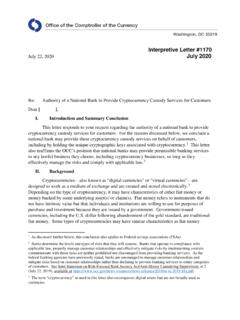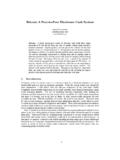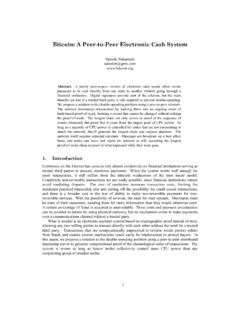Transcription of Analysis of Large-Scale Bitcoin Mining Operations
1 White Paper Analysis of Large-Scale Bitcoin Mining Operations (or how Bitcoin miners make $845 Million a Year). Introduction of the Modular Bitcoin Mining Container For inexpensive, efficient and rapid cluster deployment. Table of Contents What is Bitcoin Mining ? .. 3. Industrial-Scale Bitcoin Mining of Today .. 3. Example #1: Cointerra TerraMiner IV Mining Cluster .. 4. Example #2: ASICM iner Gen3 - Most Efficient Next-Gen 4. Challenges of Industrial Mining .. 5. Data Center Mining .. 5. Purpose Built Large-Scale Mining Facilities .. 6. KnC Miner 10MW Facility 14,500m (156,000 sq ft) .. 6. MegaBigPower Mine 1900m (20,000 sq ft).
2 6. ASICM iner 500kW Immersion Cooling 30m (300 sq ft).. 7. 250kW IceDrill Mine .. 8. Larger Facilities, Larger Investments, Higher Risks .. 8. Shorter Lifespan, More Resources, More Points of 8. Thermal Issues at Board Level .. 9. Proposed Technical Solution .. 9. Bitcoin Mining Container .. 9. System Highlights .. 9. Example Mining Container (ASICM iner Gen3): .. 10. High Density 19-Inch Slots .. 10. Fully Owned or Managed .. 10. 11. About the Author Alex Kampl is VP of Engineering at Allied Control. Contributions and edits by Mark MacAuley and Kar- Wing Lau. Alex and his team can be contacted via Allied Control is a high-tech start-up building the most efficient cooling solution for high density electronics, and 3M's Technology Partner for Novec Engineered Fluids.
3 With its unique and very different approach to cool computers, the company has attracted international attention and recently won the prestigious Best Green ICT Award for most energy efficient data center with a PUE of even in hot and humid Asia. The company intends to cool the hottest computers on the planet and believes that cryptocurrencies are the perfect incubators for passive 2-phase immersion cooling. A modular containerized data center solution for Bitcoin Mining , HPC or GPU computing will be available in 2014. Full disclosure: Alex and his company have no horse in the Bitcoin race, other than building systems and consulting for clients in the Bitcoin industry.
4 3M and Novec are trademarks of the 3M Corporation. POD Architecture is a registered trademark of Digital Realty Trust. CoinTerra and TerraMiner are trademarks of the CoinTerra Company. Copyright 2014 Allied Control Limited Page 2. What is Bitcoin Mining ? Simply put, Bitcoin Mining is the process of creating new Bitcoins by verifying the transactions in the Bitcoin network. Today, this is mostly done using purpose-built Bitcoin Mining devices which are used to solve a mathematical problem (hashing). Miners get rewarded with 25 new Bitcoins per new block in return. A new block is generated approximately every 10 minutes, resulting in a total of million Bitcoins or $845 million per year at current valuation.
5 The cost of verifying transactions is the capital cost to buy miners, the power consumption of running the hardware, plus operational expenses to keep the operation running. The more computational power is employed to do the hashing , the bigger the share of the total reward that goes to the miner. To stabilize the block creation rate at one block about every 10 minutes, the network self- adjusts the difficulty of the hashing calculations. As a result, the rate of creating new Bitcoins stays the same, no matter if there are 100 or 100,000 miners. 1. Industrial-Scale Bitcoin Mining of Today While Bitcoin Mining initially used to be carried out at home, in basements and in makeshift " Mining farms", we see an increased move to industrial-scale data center Mining by investors, Mining groups, cloud Mining providers and device manufacturers.
6 One such manufacturer is currently building a 10MW data center next to Facebook in Sweden 2, and there are currently more than a dozen known manufacturers engaged in developing ASIC chips for Bitcoin or other cryptocurrencies, including in the USA, Russia, Europe and China. All this new hardware will add additional resources which have to be powered. During the past 24 months, the networks total hash rate has grown exponentially. Despite increased hashing device efficiency (from GPU based Mining to 28nm ASIC based Mining ) the global power required for Mining -devices has grown 147 times in the past year alone.
7 The power that supports the current Bitcoin network is estimated to be 250-500MW 3, and will double or could even triple during the next 12 months just from one hardware manufacturer alone. 4. Cooling energy, the power required to keep Mining devices and Mining farms cool, is estimated to account for an additional 30-50% on power consumption globally. It is this component of the overall electricity need that is the most variable and also the most addressable as different technologies can be implemented to reduce the cooling electricity overhead substantially. Figure 1: 24 Month Growth of Bitcoin Total Network Hashrate 1.
8 2. 3. 4. #msg5025133. Page 3. Example #1: Cointerra TerraMiner IV Mining Cluster The TerraMiner IV (manufactured and sold by Cointerra Inc in Texas) is presently one of the popular devices and the company claims to power 6% of the entire Bitcoin network. It comes in the form factor of a 4U enclosure and uses four 28nm ASIC chips with 500W each. The chips are water cooled with a server grade water cooling system consisting of water blocks, 2 pumps, 2 custom radiators, 5. cooling fans in the enclosure and additional fans in the two power supplies. Total power consumption is 2000W (2kW) at a performance of (Terrahashes per second) and a price of $6000.
9 Figure 2: Cointerra TerraMiner IV. As of this writing, the total network hash rate is estimated to be 35PH/s (Petahash/s), which is the equivalent of around 21,875 TerraMiner IV units. By extension, one would have to commission 2,188. units worth $13 million to own 10% of the network, or 218 units worth $ million to own 1%. For a cluster with 600 units, at 10 units per rack, this implies a physical foot print of 1,200 / 2. / 10 = 60 high density 20kW racks @ about 60 x (8x2) ft2 = 960 ft2 of data center space to own of the network (with a hardware price tag of $ million). All this would net the miner about $60,800 per day in gross revenue at current valuations (~$643 USD/BTC).
10 5. Example #2: ASICM iner Gen3 - Most Efficient Next-Gen Cluster The Generation-3 ASICM iner chip (manufactured and sold by ASICM iner/Bitfountain) is presently considered the most efficient and least expensive Mining device to be released in 2014. The hardware will be available from ASICM iners partners and distributors worldwide, adding a total hashrate of 400PH/s to 1600PH/s to the network within this year 6. The final price is currently unknown, but the chips themselves are sold for $500 to $1000 per TH/s. Initial tests suggest a power consumption of 500W with a performance of 1TH/s and room for improvement.








